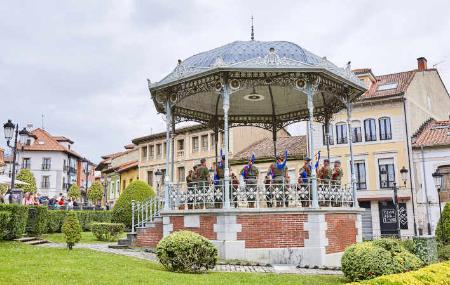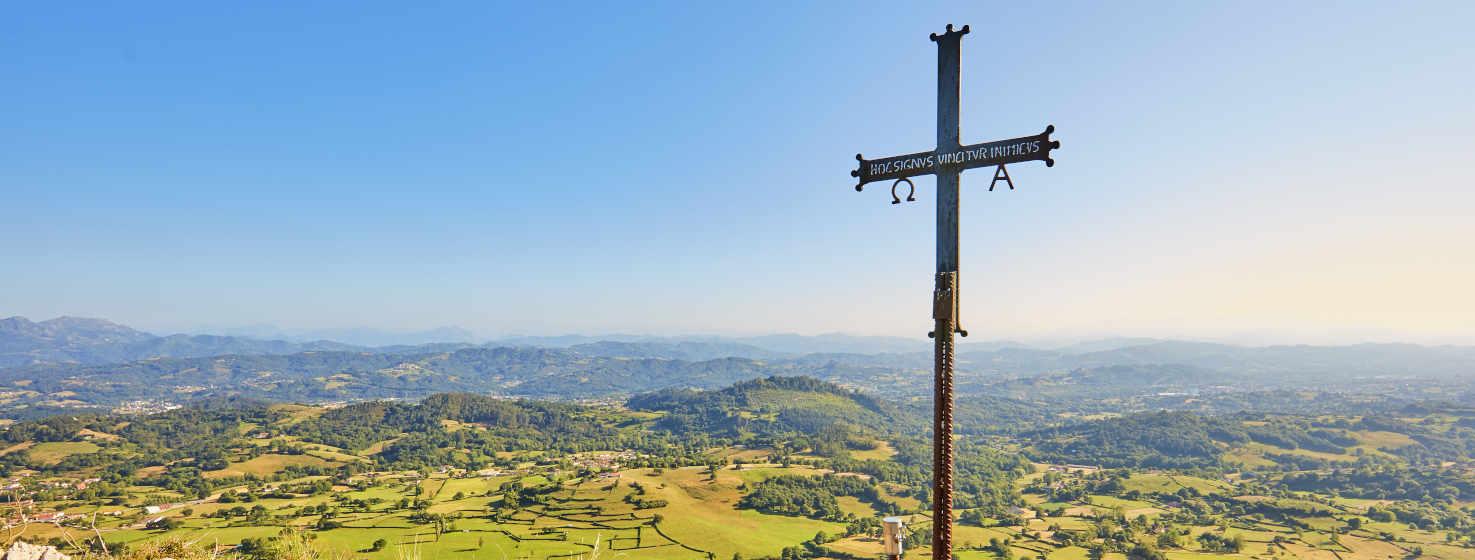
Esta comarca es una pausa en medio de la geografía montañosa de Asturias: una gran llanura, abierta y cercana a los concejos de Oviedo, Gijón y las Cuencas Mineras. Pero su centralidad no es sólo geográfica. Es uno de los corazones culturales más genuinos y palpitantes del Principado. Encrucijada jacobea también, donde el paisaje, la actividad agraria, antiguas zonas mineras y tradición ferroviaria conviven en armonía con grandes superficies comerciales y punteras áreas de empresa. Aunque hablamos de una comarca muy poblada, conserva intacta su esencia rural e histórica en sus costumbres y en la celebración de sus grandes romerías.
Patrimonio histórico y cultural
La Comarca del Nora es historia viva. Aquí confluyen la huella de Roma, el bullicio de los mercados medievales, los palacios barrocos y la silueta inconfundible de los castilletes mineros. Una secuencia de hechos y memorias que han llegado a nuestros días de distinta forma, como las excavaciones arqueológicas en Lucus Asturum (Lugo de Llanera), que tienen lugar en un área de 200.000 metros cuadrados dentro de la conocida ruta romana que comunicaba Lugo y el interior de Asturias. También en el municipio de Llanera, la Edad Media revive cada año con la Fiesta de los Exconxuraos, declarada de Interés Turístico del Principado de Asturias. Se celebra el primer fin de semana de julio y recuerda la revuelta de sus vecinos en el siglo XV, cansados de los abusos del obispo de Oviedo. Por su desafío fueron excomulgados (exconxuraos). Hoy, aquel suceso se revive con mercado medieval, pasacalles de estandartes, combates de caballeros y grandes banquetes al aire libre.
Y siguiendo con historias del medievo, hay que relatar la tradición jacobea de esta comarca. Para el peregrino que viene del oriente asturiano, Siero ha sido siempre la puerta de entrada hacia El Salvador de la Catedral de Oviedo, gracias a una variante del Camino del Norte que se desvía en Villaviciosa. Desde La Pola Siero, la ruta transcurre por San Martín de la Carrera y cruza el puente romano de Colloto camino de la “Sancta Ovetensis”. Una vez cumplido el voto, los caminantes de antaño, y los de ahora, continúan por el Camino Primitivo a Santiago o vuelven a enlazar con el Camino de la Costa, atravesando de sur a norte el concejo de Llanera, con parada obligada en la iglesia románica de Santiago de Arlós - uno de los ejemplos más destacados del románico rural asturiano -, y el principal de la zona junto a la iglesia de San Esteban de Aramil, en el vecino concejo de Siero.
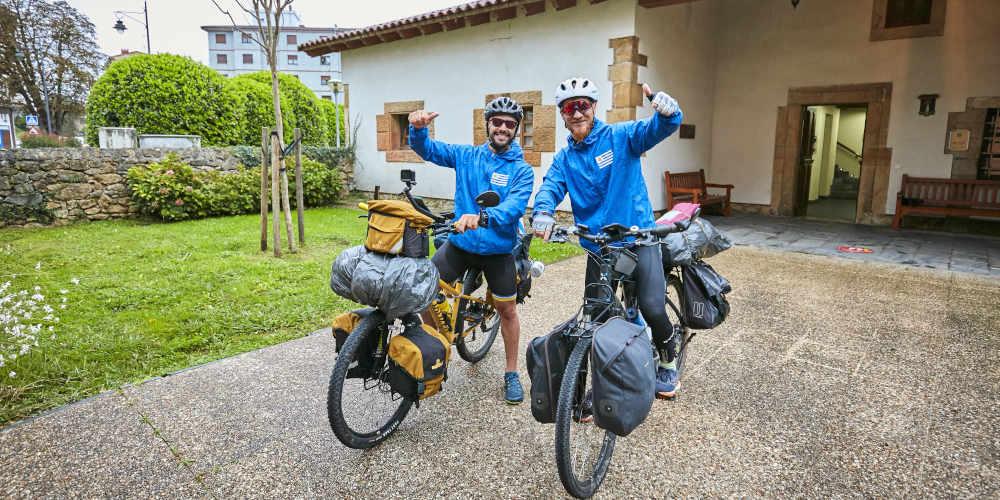
La comarca entera ofrece un espléndido patrimonio de casonas y palacios medievales, reflejo de una época dominada por la nobleza rural. La mayoría de estos inmuebles están en manos privadas, y algunos de ellos abren sus puertas como complejos hosteleros. Cabe destacar el Castillo de San Cucao, el Palacio de Villabona o el de Villanueva en Llanera; los palacios de Miraflores y el Rebollín, en Noreña, y los palacios de Meres, Celles y Valdesoto(se abre en una pestaña nueva), en Siero.
En cuanto a la tradición ganadera se refiere, el mercado de La Pola Siero es de los más antiguos de España. Fue uno de los grandes centros económicos de la Baja Edad Media asturiana, cuando el precio de una vaca podía decidir el porvenir de una familia entera. La feria ganadera ha llegado hasta nuestros días y sigue siendo una de las más importantes de Europa.
Por otro lado, la localidad de Valdesoto es uno de los grandes focos culturales de la comarca, pues mantiene vivas tradiciones ancestrales como los Sidros, figuras carnavalescas que enlazan con las antiguas mascaradas de invierno, una de las expresiones etnográficas más auténticas de Asturias. También acoge Les Carroces de Valdesoto, Fiesta de Interés Turístico del Principado en la que escenarios sobre ruedas recorren el pueblo como auténticos teatros ambulantes, dando vida a historias y personajes representados con gran creatividad y participación vecinal.

La villa de Noreña - villa, Condado y concejo – (tres en uno), combina devoción y fiesta en el Ecce Homo, celebrada a mediados de septiembre. Centenares de peregrinos acuden a la ermita del mismo nombre para formar parte de una de las procesiones más solemnes de Asturias.
La comarca también conserva curiosas tradiciones, como la Fiesta de los Huevos Pintos, declarada de Interés Turístico del Principado. Esta costumbre de decorar huevos en Pascua, muy arraigada en Siero, pudo haber llegado con los mineros centroeuropeos que se asentaron en la zona. Porque este concejo (a menudo eclipsado por las grandes cuencas del Nalón y el Caudal) cuenta con un importante pasado minero, sobre todo en Lieres y Carbayín. La llegada del tren en 1856, con la línea de Langreo, ayudó a conectar esta zona con la Asturias industrial. Prueba de ello es que la población de El Berrón sigue siendo un destacado nudo ferroviario de Asturias.
Espacios naturales y actividades al aire libre
El río Nora (afluente del Nalón) serpentea tranquilo entre alisedas, sauces y praderas, dando nombre a esta comarca y ofreciendo un montón de rutas fluviales. Como el recorrido circular de 10 kilómetros por enclaves de Llanera, entre huertas, quintanas asturianas y áreas recreativas, sin que falten antiguos molinos, presas y casonas blasonadas. Por otro lado, desde la estación de ferrocarril de La Pola Siero hasta Lieres, se puede seguir el curso del río durante unos 8 km. Para quienes busquen un paseo corto, el tramo entre el puente romano de Colloto y el Palacio de Granda, de poco más de un kilómetro, es ideal. También es muy recomendable la Ruta de los Covarones del río Tuernes, en Llanera: una senda familiar de 2,5 km (ida y vuelta), que recorre un paisaje kárstico con cuevas, arcos y túneles naturales.
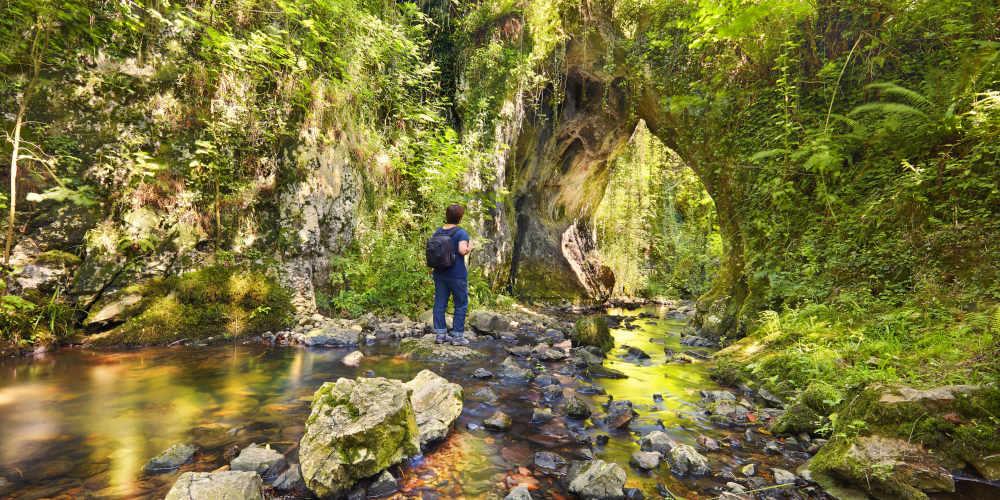
Aunque la comarca carece de grandes cimas, sí brinda ascensiones breves a cumbres panorámicas: el Picu Celles (393 m), dominando Llanera, Oviedo y con vistas a la sierra del Aramo; o Peña Careses (563 m), accesible por la senda PR AS-216. Una opción familiar es la ruta Vega de Poja - Picu Castiellu (437 m), 5 kilómetros de ida y vuelta entre praderías, castaños y robledales.
Para una caminata con historia, la Ruta Minera de Jovellanos (PR AS-174) recuerda el viaje a caballo que hizo el ilustrado gijonés en 1790, para visitar las minas de Carbayín. El itinerario circular, de 24 kilómetros, avanza por una zona rural que fue cuna de la actividad extractiva asturiana desde el siglo XVIII. En el camino destaca Carbayín Bajo, con su Monumento al Minero o el pozo Pumarabule, cuya chimenea y castillete de 1917, están incluidos en el inventario del Patrimonio Cultural de Asturias. El sendero discurre después por bosques, ruinas mineras y el cordal que separa Bimenes y Siero, ofreciendo bellas vistas panorámicas. En el tramo final, el paisaje se suaviza entre pomaradas y casonas, hasta regresar al entorno del Palacio de Valdesoto, de donde habíamos partido.

Ahora bien, la Comarca del Nora, con su combinación de suaves llanuras, verdes praderías y caminos históricos, no es sólo idónea para un senderismo sin excesos, sino que prácticamente cualquiera de sus itinerarios son posibles y asumibles en bicicleta (Más info: cicloturismo en la comarca del Nora).
Para los amantes del green, el campo de golf de La Morgal supera los 260.000 m², y alberga la mayor zona de prácticas de toda Asturias para poder iniciarse a gusto en este deporte. También en Llanera, se encuentra el santuario del asturiano más rápido de todos los tiempos: Museo y Circuito Fernando Alonso. Aquí se conserva su historia con mimo: el kart con el que empezó todo, algunos de sus coches de Fórmula 1, cascos, trofeos, monos de carreras, etc. Y si somos verdaderos amantes del motor y la velocidad, podemos poner a prueba nuestra pericia al volante alquilando un auténtico kart de carreras, rodando en el circuito que el propio Alonso diseñó. Un trazado muy serio, homologado para competir.

Si después de tanta actividad aún nos quedan ganas de despegar los pies del suelo, en el aeródromo de La Morgal también podemos volar - literalmente -. Tenemos la opción de contratar vuelos divulgativos en avioneta, alcanzando vistas aéreas de los paisajes más asturianos que uno pueda imaginar. Para los más atrevidos, existe incluso la posibilidad del bautismo aéreo: subir con un instructor y, por un rato, tomar los mandos.
Información práctica para el visitante
Es muy fácil terminar recalando en esta comarca porque todos los caminos conducen a ella. A diez minutos de Oviedo/Uviéu, Gijón/Xixón o las cuencas mineras, está perfectamente integrada en el corazón del área metropolitana asturiana. En coche, tren o autobús, el acceso es sencillo. Las carreteras A-66 y AS-II la atraviesan, y las estaciones y apeaderos ferroviarios a lo largo de sus principales localidades - Colloto, Lugones, Noreña, Lugo de Llanera, El Berrón o La Pola Siero -, permiten conocerla a fondo sin coche.
Supera los 70.000 habitantes, y ocupa las primeras posiciones entre las áreas de más afluencia y transito diario de Asturias. En lo económico, es una de las más pujantes de la región, gracias a potentes núcleos industriales: Asipo, Silvota, Bobes o el Parque Tecnológico de Llanera. Un punto neurálgico para el gran público es Parque Principado: la mayor área comercial y de ocio de toda la comunidad autónoma, con más de 75.000 m² de superficie. Es un buen refugio para los días lluviosos por sus numerosos comercios, salas de cine, recreativos y restaurantes franquiciados.
Pero la Comarca del Nora es también una de las almas verdes de Asturias. Es bella y natural; produce, trasiega, cultiva la buena vecindad, cura embutidos y, sobre todo, vive a tope su asturianía en un calendario marcado por citas irresistibles. El Carmín de La Pola, celebrado el lunes siguiente al 16 de julio - día de la virgen del Carmen -, no es una fiesta, es una institución. Los polesos, gente de alegría contagiosa y garganta afinada, se agrupan en peñas y, al son de las charangas, marchan cantando desde la histórica plaza de Les Campes hasta el prau de la fiesta. Visten de blanco, con el inconfundible pañuelo azul al cuello. Gaitas por doquier, una Danza Prima que une generaciones, sidra que corre generosa, tortillas, y el espíritu colectivo de la comida campestre convierte la jornada en una celebración profundamente astur, conocida con justicia como "la gran romería de Asturias".
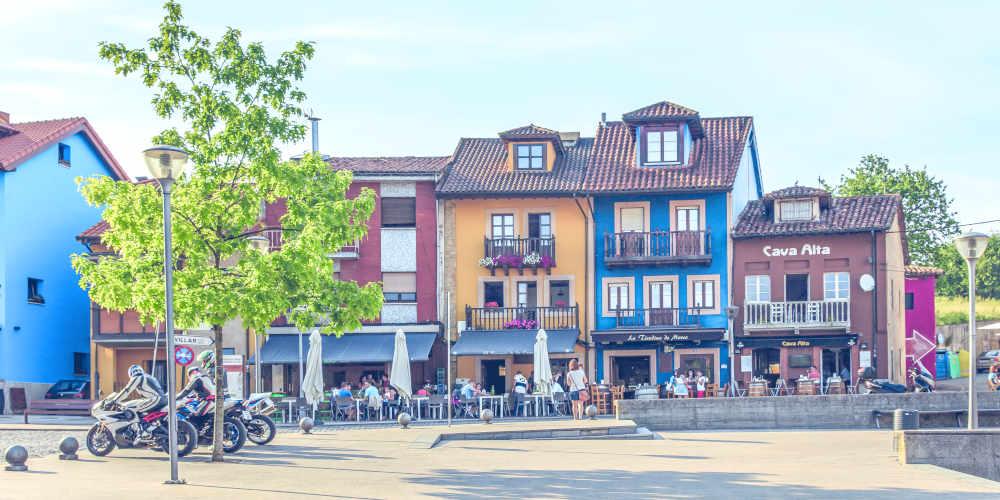
A principios de diciembre, Noreña convierte su famosa tradición de cocinar callos (pequeñinos y algo picantes) en una gran celebración: la Fiesta de los Callos. Asimismo, el lunes más próximo al 25 de abril (San Marcos), en esta localidad también tiene lugar la Fiesta del Picadillo y El Sabadiego, Fiesta de Interés Turístico del Principado. El picadillo, mezcla sabrosa de carne magra de cerdo aliñada con pimentón, ajo y sal, se sirve frito con tortos o patatas; por su parte, el Sabadiego es un embutido exclusivo de Noreña, elaborado con carne de cerdo, morcilla y especias. La Orden del Sabadiego, creada en su honor, es una cofradía gastronómica consolidada que ha paseado por toda España la tradición chacinera del concejo. Por todo ello, no sorprende que en esta villa nos topemos con el “Monumento al gochu” (cerdo), una escultura que lo honra como patriarca de una de las industrias cárnicas principales de Asturias.
Sumemos a los embutidos y carnes del gochu, buenas hortalizas, quesos con carácter como el de Varé, ternera para cachopos de campeonato y fabes de la granja de Argüelles - población sierense con gran tradición en su cultivo -. Añadamos casadielles o frixuelos como broche dulce, y obtendremos un recetario claro y sabroso de la comarca. Todo ello debe regarse, por supuesto, con sidra de la zona, pues Siero es el tercer concejo de Asturias en número de llagares (bodegas de sidra), destacando especialmente la parroquia de Tiñana, Algunos de estos llagares ofrecen espichas, visitas guiadas o catas, y una buena parte cuentan con restaurantes propios adjuntos a sus instalaciones. En toda la comarca abundan los restaurantes que anteponen el nombre de “llagar“ para dejar claras sus intenciones culinarias. Desde Bobes hasta Colloto, pasando por Granda, Argüelles, Noreña, Lieres, Hevia, Viella, La Fresneda, Pruvia, Posada de Llanera, La Pola Siero o Lugones, estos “llagares” son auténticas instituciones. Suelen ser espacios amplios, con salones rústicos, terrazas generosas y buenas mesas abiertas al verde asturiano.
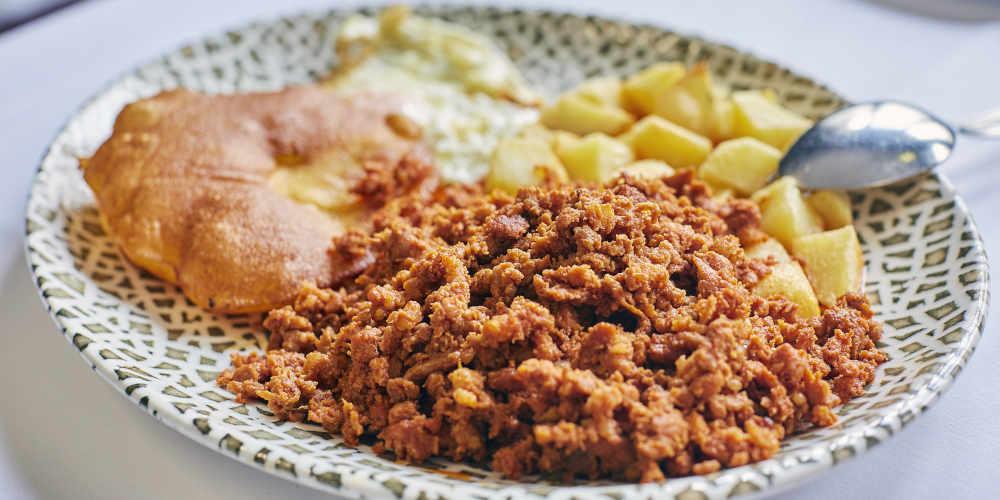
Si viajamos con niños, la comarca ofrece dos propuestas ideales: el Núcleo Zoológico de Tuernes, con más de 200 animales de 23 especies, incluidos dromedarios, búfalos o alpacas; y el museo El Taller de Títeres, que combina un taller interactivo y una exposición con piezas de todo el mundo.
La Pola Siero (capital administrativa y cabecera de la comarca) y Lugones (localidad más poblada con cerca de 15.000 habitantes) son las poblaciones que más dinamizan la oferta cultural de la zona. La Pola gracias a su moderno Teatro-Auditorio, y Lugones con la extensa agenda promovida por su popular Centro Polivalente Integrado.
Existen numerosas opciones de alojamiento en la comarca, que van desde hoteles que ocupan sobrios palacios y casonas medievales, hasta hospedajes urbanos de todo tipo, o una amplia red de casas rurales en viviendas típicamente asturianas.
La Comarca del Nora es un territorio con una gran calidad de vida, afable, abierta y festiva, donde la buena vecindad y el carácter hospitalario siempre van por delante. Todo aquí, de forma natural y generosa, huele a vida buena.
Galería de Imágenes
Mapa
Qué ver
- Siero Minero y Ruta Minera de Jovellanos.
- Mercado de ganado.
- Fiestas de Interés Turístico (Huevos Pintos, El Carmín).
- Casco Histórico de Noreña, fiesta y actividad de interés turístico (Fiesta del Picadillo y del Sabadiego).
- Palacios de Llanera.
- Circuito Fernando Alonso y la Morgal.



